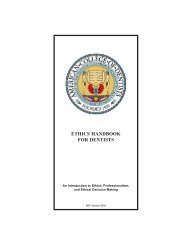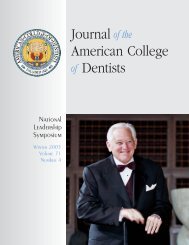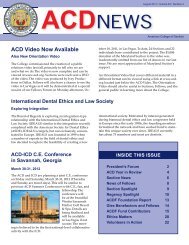Journal of the American College of Dentists
Journal of the American College of Dentists
Journal of the American College of Dentists
Create successful ePaper yourself
Turn your PDF publications into a flip-book with our unique Google optimized e-Paper software.
Students’ Views on Ethics<br />
August 2011 and included articles published<br />
and available in print or online at<br />
that time. A cursory search was performed<br />
initially to identify potential<br />
articles pertaining to <strong>the</strong> topic <strong>of</strong> interest<br />
based on title and abstract. The initial<br />
inclusion criteria were (a) publication in<br />
English, (b) abstract available on<br />
PubMed, (c) content relevant to patients’<br />
understanding or retention <strong>of</strong> information<br />
given prior to orthodontic treatment<br />
or orthognathic surgery, and (d) full<br />
article available online using University<br />
<strong>of</strong> California, San Francisco remote<br />
access. Studies were fur<strong>the</strong>r selected to<br />
be included in <strong>the</strong> final list <strong>of</strong> publications<br />
to be reviewed in this article based<br />
on <strong>the</strong> level <strong>of</strong> evidence. Articles were<br />
excluded from <strong>the</strong> review<br />
if <strong>the</strong>y did not meet <strong>the</strong> initial inclusion<br />
criteria or if <strong>the</strong>y were editorials, expert<br />
opinion, or case reports.<br />
Results<br />
An electronic search on PubMed using<br />
<strong>the</strong> aforementioned set <strong>of</strong> keywords<br />
identified 564 articles. Of those, 511<br />
were written in English, and 483 articles<br />
had abstracts available. Through review<br />
<strong>of</strong> title and abstracts, 21 articles were<br />
identified to be on relevant topics, and<br />
11 were subsequently excluded from<br />
<strong>the</strong> review due to <strong>the</strong> nature <strong>of</strong> <strong>the</strong><br />
Table 1. Result <strong>of</strong> Electronic Search in PubMed Database<br />
Satisfied initial<br />
inclusion criteria<br />
publication and <strong>the</strong> level <strong>of</strong> evidence<br />
<strong>the</strong>y provided. Within <strong>the</strong> final list <strong>of</strong><br />
ten articles, four were on patients’ comprehension<br />
or retention <strong>of</strong> orthodontic<br />
information, one on patients’ comprehension<br />
and retention <strong>of</strong> orthognathic<br />
surgery information, and five were<br />
related specifically to efficacy <strong>of</strong> various<br />
communication modes in presenting<br />
orthodontic information to patients<br />
(Table 1).<br />
The level <strong>of</strong> comprehension and<br />
retention <strong>of</strong> orthodontic information<br />
through <strong>the</strong> informed consent process as<br />
well as o<strong>the</strong>r supplemental items was<br />
evaluated in four studies, and <strong>the</strong> major<br />
findings are summarized in Table 2.<br />
Baird and Kiyak (2003), in a study with<br />
a sample <strong>of</strong> 21 children receiving Phase I<br />
orthodontic treatment and <strong>the</strong>ir parents,<br />
assessed understanding <strong>of</strong> informed<br />
consent through open-ended interview<br />
questions regarding reasons and risks<br />
for treatment. The child and <strong>the</strong> parent<br />
were interviewed separately. A chart<br />
review was performed to reveal information<br />
reviewed in <strong>the</strong> consent, and a<br />
vocabulary test was completed. The<br />
study revealed that, overall, parents and<br />
children knew very little about <strong>the</strong><br />
child’s diagnosis, and while <strong>the</strong> chart<br />
listed just over four reasons for treatment<br />
on average, parents could only recall<br />
Full text<br />
available<br />
Selected<br />
Comprehension/Retention <strong>of</strong> 13 6 4<br />
orthodontic treatment information<br />
Comprehension/Retention <strong>of</strong> 3 1 1<br />
orthognathic surgery information<br />
Communication method in presenting 7 5 5<br />
orthodontic information<br />
about two on average and children only<br />
one. Fur<strong>the</strong>rmore, regarding risks <strong>of</strong><br />
treatment, 12 children and seven parents<br />
stated that <strong>the</strong>re were no risks associated<br />
with orthodontic treatment, and ano<strong>the</strong>r<br />
five children and five parents could not<br />
recall any risks. The study showed a<br />
correlation between education and<br />
vocabulary level, and <strong>the</strong> number <strong>of</strong><br />
reasons and risks reported by parents<br />
and children.<br />
In a similar study <strong>of</strong> 33 low-income<br />
children beginning <strong>the</strong>ir early orthodontic<br />
treatment, Mortensen and colleagues<br />
(2003) examined patient and parent<br />
comprehension <strong>of</strong> <strong>the</strong> child’s Phase I<br />
orthodontic treatment with regard to <strong>the</strong><br />
purpose <strong>of</strong> treatment, possible risks, and<br />
responsibilities <strong>of</strong> children and parents.<br />
The study showed that, on average, <strong>of</strong> <strong>the</strong><br />
2.34 reasons for treatment presented,<br />
patients recalled 1.10 and parents 1.66.<br />
For 2.45 items on procedural information<br />
presented, <strong>the</strong> recall rate was 1.55<br />
and 1.59 for patient and parents, respectively.<br />
That <strong>of</strong> risks was 0.66 and 1.48,<br />
respectively, even though 4.66 items<br />
were mentioned by <strong>the</strong> orthodontist on<br />
average. As for patient’s responsibility,<br />
number <strong>of</strong> average recalled items was<br />
greater: 2.21 for patients and 2.07 for<br />
parents, out <strong>of</strong> 3.38 presented. The only<br />
exception to <strong>the</strong> low recall rate was<br />
parents’ reports <strong>of</strong> <strong>the</strong>ir responsibilities<br />
associated with <strong>the</strong>ir children’s treatment<br />
as <strong>the</strong>y listed more than what <strong>the</strong><br />
orthodontist had mentioned. Most <strong>of</strong><br />
<strong>the</strong>se items were responsibilities for children,<br />
not parents. In all but one part <strong>of</strong><br />
informed consent, parents recalled more<br />
than children; <strong>the</strong> exception was on<br />
what <strong>the</strong> child should do for a successful<br />
outcome. Children’s recall rate was low<br />
regardless <strong>of</strong> vocabulary level, but vocabulary<br />
levels <strong>of</strong> parents were significantly<br />
correlated to <strong>the</strong>ir recall rate.<br />
A study conducted by Ernst and o<strong>the</strong>rs<br />
(2007) in <strong>the</strong> United Kingdom aimed to<br />
30<br />
2011 Volume 78, Number 4





